Cozumel and the Cenotes, Yucatan, MexicoContents of this Issue: Bahamas Aggressor, The Bahamas Cozumel and the Cenotes, Yucatan, Mexico Will the Sport of Scuba Diving Survive? You’ll Need More Than That to Get Me to Visit Misfortune Follows the Siren Fleet Regulator Servicing: Do It Every Two Years Wooden Hulls, Tumble Dryers and Single Engines A Taste of New Products at DEMA 2017 What a Fish Knows: The Inner Lives of our Underwater Cousins Plastic is Suffocating the Ocean Catastrophe at Cocos Island, Costa Rica Editorial Office: Ben Davison Publisher and Editor Undercurrent 3020 Bridgeway, Suite 102 Sausalito, CA 94965 commuting to the caverns from the January, 2018 issue of Undercurrent
Dear Fellow Diver, Hot sun and margaritas were at the top my list when I decided to plan a diving trip to Mexico's Caribbean coast. However, my editor, Ben, wasn't interested in a Cozumel story, saying that he has covered it often. I explained that I would spend several days commuting to the mainland to dive the cenotes [seh-noh'- tees]. After all, the Yucatan is perforated with clear, freshwater-flooded underground caverns and prehistoric cave systems, just the opposite of Cozumel's ocean drift diving. He perked up. "OK, let's show the more adventurous how they might expand Cozumel's diving horizons."
The first day, we took our gear by $2 taxi-ride to the 8.30 am ferry, Barcos Caribe. The basic round trip was 200 pesos (about $10). My middle-eastern background stood me in good stead, and I eventually bargained the fare down to 110 pesos! The Caribe has two decks, can carry about 300 people and the passengers were mostly Mexican's making the 45-minute commute to work. A shop serves weak coffee with powdered milk and a choice of potato chips. There was a first-class section, but we weren't in it. Upon arrival at Playa del Carmen, Hector, our tall, impressive cenote guide from The Scuba Tribe (which works with Deep Blue) met us and drove us for 20-minutes in his four-wheel-drive twin-cab truck to our first cenote called 'Kulkulcan' at Chac Mol. A serious fellow, Hector spoke perfect English, and he knew his stuff! When it came to briefings, he was authoritative. Safety first. He would take no chances.
Wearing wetsuits and fully equipped with conventional scuba gear -- he provided tanks, weights and lights -- we walked to the first cenote entrance close to where the truck was parked. About a dozen concrete steps took us to the edge of Kulkulcan, a stunning open cavern. I was in awe as sunlight streamed through the trees and into the water's entrance. The kind of thing you see in the movies, digitally enhanced. Hector kept a watchful eye, as we followed the guideline strung along the wall. His dive lights were powerful, so there was no chance of missing anything. Visitors may not bring cameras into the cenotes because unskilled photographers have damaged the million-year-old fragile environment, so a professional photographer was on hand to shoot us while inside. (At $70, his shots were worth every penny. He also provides videos and maps of the cenotes and their short history in five languages). The first dive was about 40-minutes and 45 feet (14m) deep. I was overwhelmed, though slightly disappointed by the lack of stalactites and stalagmites. The second dive was nearby at Little Brother. Much darker than Kulkulcan, it sported modest stalactites and stalagmites, and we entered a shallow airspace where I could see tree roots. For the next day, Hector, now confident in our abilities, agreed to take us to a more dramatic cenote, where he will not take those without perfect buoyancy control. The next day, Hector drove us to Dreamgate, an hour and twentyminute trip. After a great deal of laughter while kitting up, and a dive briefing with safety reminders, we followed Hector into the big and inviting entrance. Stalactites, like stone icicles, some with sharp points, hung threateningly overhead. Stalagmites rose beneath us like bear traps, daring us to drop. At only 20 feet (6m) deep, perfect buoyancy control was essential. As we followed our flashlight beam farther into the gloom, my eerie feeling dissolved into awe and wonder of the cavern's majesty. One minute I was swimming through narrow tunnels, while the next I was slipping through an arch into an astounding cathedral-like opening. These stalactites and stalagmites formed after the last Ice Age before sea levels rose. They had seen the dinosaurs, accepted sacrifices, provided water and presumed by some to be the gateway to the afterlife.
After a few days of reef diving back on Cozumel, we spent our final day cenote diving, recognizing that my gear would be rinsed in clean, fresh water before the trip home. Clever, eh? Having concluded we were suitably skilled divers, Hector took us to a more advanced dive site. Getting to Takbelum required a 90-minute drive into the Mayan jungle, and Hector became "Indiana Jones" as we bumped slowly and uncomfortably along a rutted track. A long wooden staircase from the surface entrance leads to the cenote. The cave itself is long but shallow, and we dived at a maximum of 23 feet (7m) but usually between 10 and 13 feet (3 and 4m), avoiding the abundant sediment that could be stirred up by careless fin strokes.
The stalactites and stalagmites appeared like molten wax, huge and ancient. We swam into enormous amphitheaters, grand halls with hidden caves. With no daylight, I was mindful of the guideline, never venturing more than an arm's length away. Without discussing it, we tourists became watchful of one another, reprimanding anyone who wandered even a tiny bit farther than instructed. After the dive, we hauled our tanks up the long stairway, and then returned with full ones for one last dramatic dive. Many of the cenotes had a pulley system used to send the tanks down to the entrance, and back up (if you wished). Although we were the only divers inside this cenote, a large noisy gang of young people arrived in jeeps and enthusiastically zip-wired into the water when we finished. Hector provided delicious sandwiches and a choice of drinks after each dive while spinning great cenote stories, some gruesome and tragic. He made the experience enjoyable and instilled confidence that made the cenote diving relaxing and safe. So, if you're going to try cenote diving, Hector's the man.
The Rock 'n Java Bar 'n Grill a few yards away offered a breakfast of refried beans, rice and anything with 'chili', eggs, seasonal fruit and pancakes and as much coffee as your bladder can hold. Oh, and you can watch cadets at school practicing drills while you eat. In town, the few restaurants facing the Malecon are mostly tourist traps with views. At Palmeras, we had copious guacamole with nachos, then perfect fajitas, and melt-inthe- mouth steak or chicken and ran about $20 per head. Casa Cuzamil on Avenida Sur offered local food with friendly service at about $15. Machete was cheap, quick, and satisfying and served burgers. For $15 per person, La Lobsteria (Cnr. of Avenida 5 and Calle 7) offered delicious lobster, great service, and a quaint garden. The downside? Mosquitos galore in the evenings, everywhere. I covered up and slathered myself with DEET! Though Ben wanted only a cenote review, I must add something about the reef diving, which began with a no-hassle pick up at the jetty by Deep Blue's panga. I carried my gear from my second-floor room every day (I prefer my own BCD and regulator, not to mention my 20-year-old Mares fins, and my well-worn 3mm suit). One of my buddies rented her gear, and though it was well used, it worked well and was on the boat and set up when it arrived. Their pangas hold about ten divers -- that would be too cozy -- and there is no place to keep anything dry, so bring a dry bag for your personal stuff. It was a 30-minute speedy ride to the first dive. Our relaxed and youthful dive guide, Carlos, ensured everything was in order and made his expectations clear. Donning my gear, I snapped my fin strap right out of its buckle! Quickly, the other dive guide fixed it with a cable tie. The first site was "Palancar Bricks," a colorful reef with its swim-thru's and profuse life. The variety of sponges, the lovely soft and hard coral was spectacular, the colors intensified by the sun. The 65-feet (20m) visibility was great for viewing the two turtles and a nurse shark that we drifted past. During the week I also dived Palancar Caves, Palancar Gardens and Paseo de Catedral for fast drift dives, and moved along the big pinnacles of Columbia (the longest boat ride, 45 minutes). There were rays aplenty, as were the seahorses in the grass. Huge spiny lobsters watched me with their beady eyes. Splendid toadfish hid in cracks. Anemone shrimp perched for a view. Angelfish, triggerfish, grouper, and puffers swam around without a care in the world. Barracuda guarded from above, and all sorts of morays peeked out for a look, mouths agape. The day's four dives were split with an hour surface interval, where either we were dropped for lunch at Paradise Beach, a large resort that caters to the gargantuan cruise lines or we could return to the dock and our hotel. Between dives, there were bananas, pastries or cake and plenty of bottled water. Another guide, Paulo Maçarico, a well-traveled diver and photographer was relaxed and terribly funny. Underwater, he had perfected the art of unobtrusive supervision but still pointed out unique sea life. A third guide, however, tended either to herd his group or at swim way ahead of them. I assume he thought his divers were sufficiently experienced, but that's how accidents happen. Many inexperienced divers visit Cozumel, and I was shocked to dive with a physically impressive father-of-two, who was less impressive in the water, where he yoyo'd from 50 feet (15m) to 16 feet (5m) throughout the dive. Why the dive guide didn't intervene was a mystery. Also, Cozumel currents can get woolly; it seems that just about every year someone is dragged deep by down currents and some divers have never returned. That said, it is just about the Caribbean's top diving destination -- and certainly among the least expensive -- but newly certified or nervous divers ought to get their experience elsewhere before visiting. For everyone else, have at it. And don't overlook the cenotes. -- F.M. Our Undercover Diver's Bio: F.M., a mother-of-two, has been diving since 1979, but after a hiatus became enthusiastic in the mid-90s, visiting dive sites as different as Scapa Flow and the Outer Hebrides of Scotland, Iceland, and Vancouver Island, to the Caribbean, the Galapagos, Yemen, and Truk Lagoon. Nowadays she often travels with a girlfriend, leaving her long-suffering husband at home.
|

I want to get all the stories! Tell me how I can become an Undercurrent Online Member and get online access to all the articles of Undercurrent as well as thousands of first hand reports on dive operations world-wide
| Home | Online Members Area | My Account |
Login
|
Join
|
| Travel Index |
Dive Resort & Liveaboard Reviews
|
Featured Reports
|
Recent
Issues
|
Back Issues
|
|
Dive Gear
Index
|
Health/Safety Index
|
Environment & Misc.
Index
|
Seasonal Planner
|
Blogs
|
Free Articles
|
Book Picks
|
News
|
|
Special Offers
|
RSS
|
FAQ
|
About Us
|
Contact Us
|
Links
|
3020 Bridgeway, Ste 102, Sausalito, Ca 94965
All rights reserved.

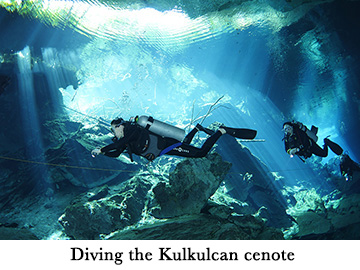 Two other friends persuaded, date agreed, and flights booked, off we went.
When the August heat hit me as I disembarked my flight, I needed the first taste
of Mexico, a celebratory Piña Colada. A
bus and ferry ride took us to Cozumel.
Deep Blue had booked us into the
Barracuda Hotel just south of the Punta
Langosta pier and a short walk to town.
Two other friends persuaded, date agreed, and flights booked, off we went.
When the August heat hit me as I disembarked my flight, I needed the first taste
of Mexico, a celebratory Piña Colada. A
bus and ferry ride took us to Cozumel.
Deep Blue had booked us into the
Barracuda Hotel just south of the Punta
Langosta pier and a short walk to town.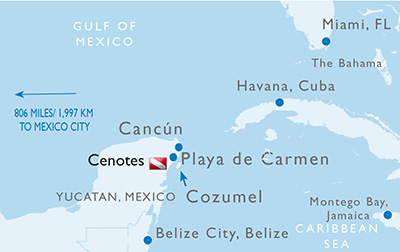 While examining our dive qualifications,
he was visibly surprised at how many dives we had made: one of us had
2000 plus dives, the other more than 1000 and I, a measly 700 dives including some
cavern and cave experience. Satisfied, he proceeded to explain the procedures as
if we were novices. In fairness, although we are all experienced wreck divers and
have dived in dark and tight places, he was right to be strict and sober. Cenotes
are different and not to be taken lightly. He called these first dives 'cavern
dives' as opposed to cave diving, explaining that we would be able to see the blue
of daylight almost all the way through the dive.
While examining our dive qualifications,
he was visibly surprised at how many dives we had made: one of us had
2000 plus dives, the other more than 1000 and I, a measly 700 dives including some
cavern and cave experience. Satisfied, he proceeded to explain the procedures as
if we were novices. In fairness, although we are all experienced wreck divers and
have dived in dark and tight places, he was right to be strict and sober. Cenotes
are different and not to be taken lightly. He called these first dives 'cavern
dives' as opposed to cave diving, explaining that we would be able to see the blue
of daylight almost all the way through the dive.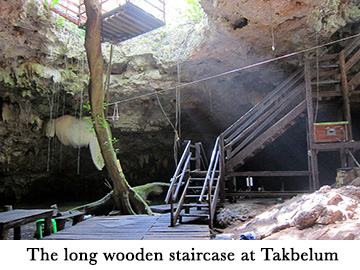 Under our lights, the calcite columns became
shades of green and yellow, sometimes stamped with fossils of vegetation or
shells. Some looked like candles dripping wax, others like layers of fabric piled
high, and some looked as if wooden dowels were sticking out. I swam through arches
and narrow gaps between thin narrow pillars and ancient columns, the water so
clear and clean it almost seemed sterile, visibility limited only by the power of
my flashlight. (Hector will lend you a wide beam light, but carry a spare in your
BC pocket). Our second dive was in the same cenote, but in a different direction
that made it appear to be a different place altogether! I saw a blind white fish
or two and twice surfaced into an air hole where bats flew above. Once, a beautiful
motmot bird perched on a hanging root above our heads.
Under our lights, the calcite columns became
shades of green and yellow, sometimes stamped with fossils of vegetation or
shells. Some looked like candles dripping wax, others like layers of fabric piled
high, and some looked as if wooden dowels were sticking out. I swam through arches
and narrow gaps between thin narrow pillars and ancient columns, the water so
clear and clean it almost seemed sterile, visibility limited only by the power of
my flashlight. (Hector will lend you a wide beam light, but carry a spare in your
BC pocket). Our second dive was in the same cenote, but in a different direction
that made it appear to be a different place altogether! I saw a blind white fish
or two and twice surfaced into an air hole where bats flew above. Once, a beautiful
motmot bird perched on a hanging root above our heads.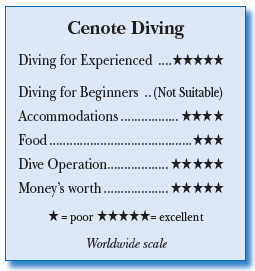 Takbelum has been featured in documentaries, such as the IMAX "Journey into
Amazing Caves," National Geographic's "The Yucatan," and a thriller, "The Cave."
Although not at all deep, this cave was not for the faint-hearted or the unskilled
diver, and we were privileged to dive it only because we had demonstrated our
chops.
Takbelum has been featured in documentaries, such as the IMAX "Journey into
Amazing Caves," National Geographic's "The Yucatan," and a thriller, "The Cave."
Although not at all deep, this cave was not for the faint-hearted or the unskilled
diver, and we were privileged to dive it only because we had demonstrated our
chops.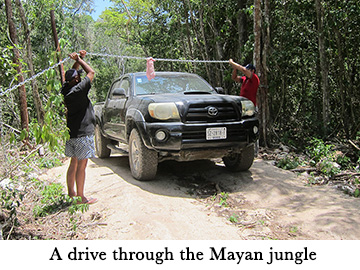 The Barracuda Hotel is a simple
hotel without pretention or luxury or
even a restaurant, but fine for our
needs. My room had two queen-size beds
-- the bedroom was air-conditioned --
and an old-fashioned shower that worked
well but took forever to drain. Daily,
the friendly staff cleaned the rooms and
changed towels, changing sheets every
other day. Since all the rooms face the
sea and are above the pool bar, they are
a fine place to sit to admire the sunset with a cold cerveza. The first night, I
thought my hotel choice a mistake when super loud music streaming from the pool
bar chased away any sleep. Thankfully, it was only a weekend occurrence and other
nights were peaceful. Nevertheless, many Undercurrent readers have complained of
this intrusion.
The Barracuda Hotel is a simple
hotel without pretention or luxury or
even a restaurant, but fine for our
needs. My room had two queen-size beds
-- the bedroom was air-conditioned --
and an old-fashioned shower that worked
well but took forever to drain. Daily,
the friendly staff cleaned the rooms and
changed towels, changing sheets every
other day. Since all the rooms face the
sea and are above the pool bar, they are
a fine place to sit to admire the sunset with a cold cerveza. The first night, I
thought my hotel choice a mistake when super loud music streaming from the pool
bar chased away any sleep. Thankfully, it was only a weekend occurrence and other
nights were peaceful. Nevertheless, many Undercurrent readers have complained of
this intrusion. Diver's Compass: I booked my trip through
Diver's Compass: I booked my trip through 